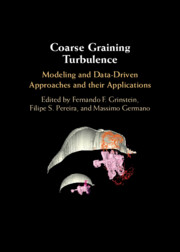Book contents
- Frontmatter
- Contents
- Contributors
- Prologue
- Part I Paradigms and Tools
- Part II Challenges
- 9 Transition to Turbulence
- 10 Wall-Bounded Turbulence
- 11 Scale-by-Scale Nonequilibrium in Turbulent Flows
- 12 Coarse-Graining in Multiphase Flows: From Micro to Meso to Macroscale for Euler–Lagrange and Euler–Euler Simulations
- 13 Coarse Graining for Thermal Flows
- 14 High-Order Simulations of Supersonic Combustion
- 15 Coarse-Graining Supersonic Combustion
- 16 Transition and Multiphysics in Inertial Confinement Fusion Capsules
- 17 Firestorms, Fallout, and Atmospheric Turbulence Induced by a Nuclear Detonation
- Epilogue
- Abbreviations
- Index
- References
15 - Coarse-Graining Supersonic Combustion
from Part II - Challenges
Published online by Cambridge University Press: 31 January 2025
- Frontmatter
- Contents
- Contributors
- Prologue
- Part I Paradigms and Tools
- Part II Challenges
- 9 Transition to Turbulence
- 10 Wall-Bounded Turbulence
- 11 Scale-by-Scale Nonequilibrium in Turbulent Flows
- 12 Coarse-Graining in Multiphase Flows: From Micro to Meso to Macroscale for Euler–Lagrange and Euler–Euler Simulations
- 13 Coarse Graining for Thermal Flows
- 14 High-Order Simulations of Supersonic Combustion
- 15 Coarse-Graining Supersonic Combustion
- 16 Transition and Multiphysics in Inertial Confinement Fusion Capsules
- 17 Firestorms, Fallout, and Atmospheric Turbulence Induced by a Nuclear Detonation
- Epilogue
- Abbreviations
- Index
- References
Summary
With high-speed turbulent combustion applications, we here mean airbreathing engine systems capable of powering aircraft at supersonic and low hypersonic flight speeds between 3 < Ma < 8. Such aircraft are most likely to be designed differently compared to today’s aircraft, being centered around a common engine duct embracing different engine systems activated at different flight speeds. For takeoff and landing, conventional turbojet engines will likely be used, whereas for cruise conditions, a dual-mode ramjet engine, capable of transi-tioning between pure ramjet and scramjet modes is preferred. Such engines do not yet exist, but experimental and computational research is currently generating data and information, paving the way toward further understanding of the aerothermodynamics. This will generate the basis for more advanced experiments that, together with high-fidelity simulations, can lead toward the realization of hypersonic flight vehicles. Here, coarse-grained reacting large eddy simulation and hybrid Reynolds-averaged Navier–Stokes or LES, together with small comprehensive reaction mechanisms, conjugate heat transfer, and thermal radiation modeling, play an important role. In this chapter, the necessary modeling steps and methods, as well as chemical reaction mechanisms, are scrutinized, and results from a few selected cases are presented to illustrate the key physical processes as well as the accuracy of present LES-based prediction methods and the remaining challenges.
- Type
- Chapter
- Information
- Coarse Graining TurbulenceModeling and Data-Driven Approaches and their Applications, pp. 455 - 493Publisher: Cambridge University PressPrint publication year: 2025

